Isabella Bradford's Blog, page 61
March 13, 2016
From the Archives: Hair Care in the 1820s-1830s
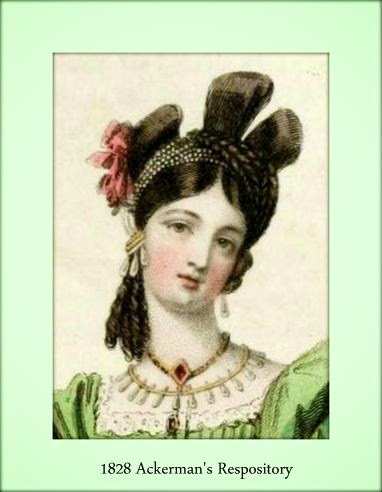 Hair for evening 1828
Loretta reports:
Hair for evening 1828
Loretta reports:Susan’s posts ( here and here )about 1770s hair care sent me to my beloved The Lady’s Stratagem by Frances Grimble.* to see how much had changed (or not) in the 1820s-1830s, the setting for my books.
For those fluent in French, the text from the original, Elisabeth Celnart's Manuel des dames (published between 1827-1833), is here . Those, like me, who aren’t fluent, will be grateful for Ms. Grimble’s translation. You will note that, as Isabella pointed out, clean doesn’t necessarily mean what a modern reader thinks it means. Recipes abound for oils and pomatums. Shampoo? Not so much. It’s more or less a last resort, as you’ll see.
“Your principal task must be to keep your hair extremely clean. Every morning, before arranging your hair, disentangle it with a large comb, holding it upright in a straight line in order not to break the hairs...When your hair has been well cleansed*...rub it with a square brush with a handle, whose bristles are very soft, or better yet are replaced with fine rice roots...
“When night comes, very gently undo your coiffure, first removing all the black pins which you find there, and shaking out the locks as you let them down. These steps are especially necessary when your hair has been dressed by a hair-dresser.”
After this the lady is urged to comb her hair well and plait it. Unplaited hair becomes damaged. It also easily escapes one’s night cap and soils the pillow.
 Hair product c. 1860
Hair product c. 1860
“When by nature, or by the prolonged or exaggerated use of oils and pomatums, your hair is greasy to the point of being dull, dense, and flat, you must resort to soap solutions. Pour a demi-tasse of lukewarm water into a saucer. Soak a very lightly-perfumed toilet-soap in the water for a few moments, and stir it a little. Soon the water will be foamy. Then spread the locks of your hair well apart, and with a sponge dampened with the soapy water, wash them well from all sides.”
You dry the hair with warm linen, then brush it with the rice brush.
Madame recommends that blond hair be “washed very rarely.”
*More about this fabulous compendium here and here and here and here .)
**by combing
Published on March 13, 2016 18:52
March 12, 2016
Breakfast Links: Week of March 7, 2016
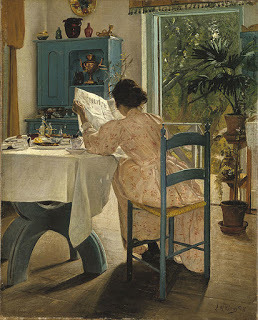 Breakfast Links are served - our weekly round-up of fav links to other web sites, articles, blogs, and images via Twitter.
Breakfast Links are served - our weekly round-up of fav links to other web sites, articles, blogs, and images via Twitter.• Was bundling in the winter really less dangerous than a sofa in the summer?
• Be amazed by the many achievements of France's most-decorated woman, Marie Marvingt.
• The bawdy history of medieval playing cards.
• Cow's dung, ash-boughs, and rose petals: how to sleep safely in early modern England.
• The truth about Lady Barrymore, the boxing baroness .
• Image: American author John Steinbeck totally used the " dog ate my homework " excuse.
• "On board the schooner Pilgrim at sea, a prisoner ."
• Days before John Adams' inauguration, his wife Abigail was working out the year's farming at home in Massachusetts.
• Waterproof garments in the 19thc.
• St. David meets the Victorians.
• Image: Beautiful flowered shoes that belonged to the Empress Josephine .
• Thirteen women who changed science.
• Edgar Allen Poe writes a story based on a Boston Harbor legend.
• Real-life "Downton Abbey": drudgery, abuse, sexual harassment.
• Making a black ball gown and social change in the 1870s.
• The "Lady Nurse of Ward E" watches the Civil War come to Washington, DC.
• Why are goats associated with the Devil?
• Battle-scarred skull from Culloden now 3D scanned.
• Image: Cats dance in The Witches Cove, a 16thc Flemish painting by a follower of Jan Mandijn.
•A baffling story from Victorian London: a mother arranges for her daughter to marry her stepfather bigamously.
• How to defraud your lord on a a medieval manor .
• The Anti-Slavery Alphabet : 1846 children's book designed to teach the ABC's of slavery's evils.
• The story of lorem ipsum: how scrambled text from Cicero became the standard for typesetters everywhere.
• Just for fun: a quiz to determine how Hungry for more? Follow us on Twitter @2nerdyhistgirls for fresh updates daily.
Above: At Breakfast by Laurits Andersen Ring. Private collection.
Published on March 12, 2016 14:00
March 10, 2016
Friday Video: The Changing Face of Europe
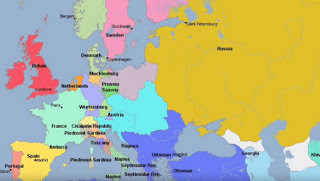 Loretta reports:
Loretta reports:Maps have changed so rapidly in my lifetime that I’ve lost track of the correct names for many countries, not to mention cities. But the problem existed in the early 1800s, too. I’ve found myself checking and double checking borders and names.
Online we can find any number of videos showing the changing face of the world. If you have one you like better, please feel free to share in the comments.
Meanwhile, I offer this “History of Europe (3000 BC-2015 AD)"
Readers who receive our blog via email might see a rectangle, square, or nothing where the video ought to be. To watch the video, please click on the title to this post.
Published on March 10, 2016 21:30
March 9, 2016
From the Archives: A Fabulous Gift to Readers from the Metropolitan Museum of Art
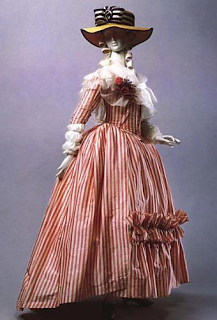 Isabella reporting:
Isabella reporting:This post first appeared nearly four years ago, but that "fabulous gift" from one of the world's greatest art museums is still available, and it's an offer well worth exploring again for new treasures. Happy hunting!
It's a long time until Christmas, but the Metropolitan Museum of Art is playing the part of Santa and giving all us Nerdy History Folks the presents early. Dozens of digital versions of the Met's out-of-print exhibition catalogues and art books are now available online for FREE.
Yes, the price that can't be beat: free. Available both as Google books to read online or as higher-quality PDFs to be downloaded, these older titles are often impossible to find as books. The digital versions aren't streamlined, either. All the original text, reproductions, and illustrations are included. Nor are these out-dated or irrelevant tomes; many of these books have permanent places on our Nerdy History Girls bookshelves.
Because the Met has such a vast and varied collection, the available books are equally diverse, ranging from ancient sculpture to medieval armor, Victorian furniture to modern musical instruments, portraits to tapestries. I can't begin to list them all here (here's the link to the search page), but I will recommend several favorite books that I own, wonderful, gloriously illustrated books produced by the Met's Costume Institute.
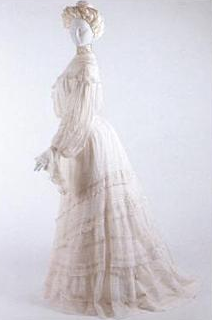
The striped taffeta robe á l'anglaise, top left, (French, c. 1785) is featured in The Age of Napoleon: Costume from Revolution to Empire, 1789-1815 . French fashion changed dramatically in this time period, from the elaborate styles set by Queen Marie-Antoinette to the classically inspired elegance of Empress Josephine. There are also chapters devoted to jewels, military uniforms, court attire, and the influence of French fashion on American women.
The white cotton mull summer dress, right, might have been worn by an American Gibson Girl c. 1902-1904. It's to be found in Our New Clothes: Acquisitions of the 1990s . This collection ranges from a court lady's late 17th c. silk mantua to a man's red velvet suit designed by Tom Ford for Gucci in the 1990s. Also included are explanations of what made each garment a specially prized addition to the Met's collection.
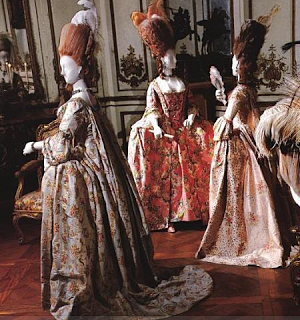 The tableau of 18th c. French gowns, lower left, is from my all-time favorite costume book, Dangerous Liaisons: Fashion and Furniture in the Eighteenth Century. This book is the catalogue to one of the most ravishing costume exhibitions ever mounted at the Met. The specially-created mannequins were posed not in display cases, but in the Museum's period rooms, almost like actors and actresses in some exquisite 18th c. drama. I love how the relationship between the ornate furnishings and the clothes is so effortlessly shown, and how the mannequins are beautifully "styled", with the appropriate jewelry, shoes, plumes, fans, and hair. It's a gorgeous, fanciful book, and one that's been highly prized (and priced!) on the used book market, and I'm so glad it's now available here.
The tableau of 18th c. French gowns, lower left, is from my all-time favorite costume book, Dangerous Liaisons: Fashion and Furniture in the Eighteenth Century. This book is the catalogue to one of the most ravishing costume exhibitions ever mounted at the Met. The specially-created mannequins were posed not in display cases, but in the Museum's period rooms, almost like actors and actresses in some exquisite 18th c. drama. I love how the relationship between the ornate furnishings and the clothes is so effortlessly shown, and how the mannequins are beautifully "styled", with the appropriate jewelry, shoes, plumes, fans, and hair. It's a gorgeous, fanciful book, and one that's been highly prized (and priced!) on the used book market, and I'm so glad it's now available here.
Published on March 09, 2016 21:00
March 7, 2016
An 1828 Guide to London Pitfalls & Scams
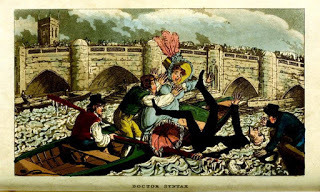 Doctor Syntax Overboard
Loretta reports:
Doctor Syntax Overboard
Loretta reports:In my Endnotes to Dukes Prefer Blondes , I quote from John Bee’s A Living Picture of London, 1828 , which is well worth exploring.
To begin with, there’s the full title:
A LIVING PICTURE OF LONDON FOR 1828 ANDSTRANGER’S GUIDETHROUGH THE STREETS OF THE METROPOLIS;SHEWING THE FRAUDS, THE ARTS, THE SNARES AND WILES OF ALL DESCRIPTIONS OF ROGUES, THAT EVERYWHERE ABOUND; WITHSUITABLE ADMONITIONS, PRECAUTIONS, AND ADVICE HOW TO AVOID OR DEFEAT THEIR ATTEMPTS; Interspersed with SKETCHES OF COCKNEY MANNERS, LIFE, SOCIETY,AND CUSTOMS;And supported throughout by numerousCASES, ANECDOTES, AND PERSONAL ADVENTURES. By JON BEE, Esq.AUTHOR OF A DICTIONARY OF THE VARIETIES OF LIFE, &c. ~To which is appended, the Author's former “HINTS FOR THE IMPROVEMENT OF THE POLICE;”WITH FURTHER SUGGESTIONS, FACTS, AND REMEDIES.
The short excerpt below, from the chapter about what to expect when you get off the boat, is a fine example. You can find the “regulated fares of watermen” here .
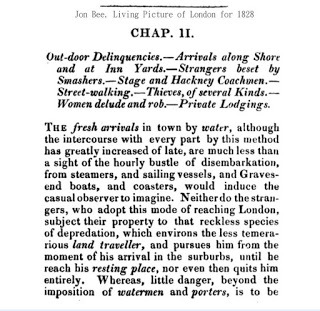 Out-door Delinquencies
Out-door Delinquencies
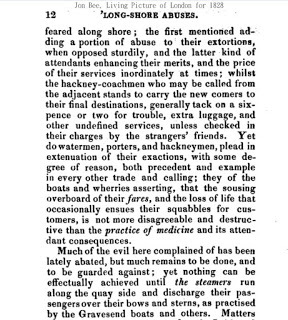
Jon Bee, A Living Picture of London, for 1828, and Stranger's Guide .
Image, possibly by Robert Cruikshank, from Doctor Syntax Through London, “Doctor Syntax Shoots London Bridge & Pops Overboard.”
Clicking on the image will enlarge it. Clicking on the caption will take you to the source, where you can learn more and enlarge images as needed.
Published on March 07, 2016 21:30
March 6, 2016
Inspired by an 18thc Dancing Dandy
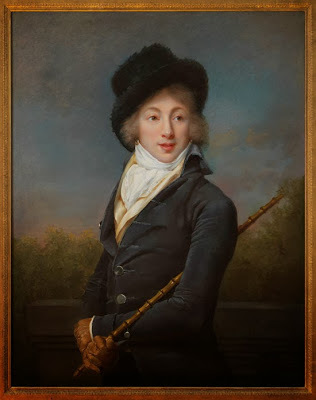 Isabella reporting,
Isabella reporting,One of the questions most asked of writers is "where do you get your ideas?" Usually I don't have the answer, since ideas just...appear.
But in the case of my newest book, A Reckless Desire, I know the idea for the story came to me when I first saw this portrait on display in the Artist/Rebel/Dandy: Men of Fashion exhibition at the RISD Museum in 2013. His name is Auguste Vestris (1760-1842), and he was (obviously) included in the exhibition for his remarkably stylish appearance – clearly a born dandy. But he was also a celebrated dancer who, with his family's ballet troupe, became the toast of 1780s London.
I wrote the following blog post about Auguste Vestris and his family at that time, but I couldn't put the flamboyant, talented Vestris family from my head. I found myself wondering what would become of the hapless child who didn't possess the talent for dancing but was born into such a family.
That child became Lucia di Rossi, the heroine of A Reckless Desire, who can't dance, but still has the desire to perform and move an audience to tears. She became the spark that started the rest of the story, inspired by the Vestris family and their life in the 18thc theater. My thanks to Monsieur Vestris himself....
In this portrait, Auguste reflects the dramatic change in men's clothing that would be embraced by gentlemen like Beau Brummell. Gone are the bright colors, extravagant wigs, embroidered waistcoats, and full-skirted coats of earlier 18th c. gentlemen . Stylish young men like Vestris now preferred a more subdued effect overall, with a new emphasis on the finer details of fit and fabric. His high-collared grey broadcloth coat is closely tailored to display his lean and athletic body. His waistcoat is pale yellow silk, barely containing his voluminous cravat of immaculate white linen. His shaggy fur hat is tipped at a jaunty angle, and he wears yellow gloves with a bamboo walking stick tucked beneath his arm. He wears his own hair, not an old-fashioned wig, and for extra dash, gold hoop earrings.
But as wonderful as this portrait is as a fashion statement, I was still curious to learn more about the sitter. Turns out Auguste Vestris was an acclaimed professional dancer and teacher with a colorful history to match his wardrobe. He was born into a dancing family: his Italian father was Gaëtan Apolline Balthazar Vestris, the most celebrated dancer of his generation in Europe and Louis XVI's ballet-master, and his mother was a much-younger French dancer, Marie Allard. Auguste followed his parents to the stage, making his dancing debut at aged 12.
By the time he followed his father to London in 1780, young Auguste had become the kind of celebrity that's usually associated with modern singers named Justin. He was called "le Dieu de la Danse" - "the God of the Dance." His performances were packed, and the ladies in particular found him and his dancing irresistible. The buzz around him was so great that on the night of a special benefit performance in 1781, the House of Commons adjourned early so the members would be able to attend; Vestris himself earned over fourteen hundred pounds that evening, an astounding amount for any 18th c. performer.
Here's Horace Walpole's droll description of Auguste-Vestris-mania:
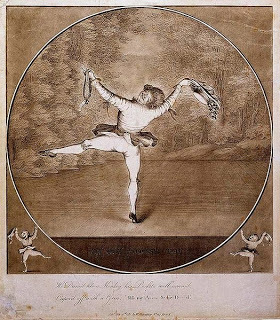
"The theatre was brimful in expectation of Vestris. At the end of the second act [of the ballet Ricimero] he appeared; but with so much grace, agility and strength, that the whole audience fell into convulsions of applause: the men thundered, the ladies forgetting their delicacy and weakness, clapped with such vehemence, that seventeen broke their arms, sixty-nine sprained their wrists, and three cried bravo! bravissimo! so rashly, that they have not been able to utter so much as a no since, any more than both Houses of Parliament."
The satiric print of a performance, right, seems to focus on Auguste's very tight breeches as well as his success. In his right hand he holds his hat, filled with bank-notes, and in the other is a full purse. The print's title Oh qui goose-toe [O che gusto] is an unsubtle allusion to Vestris's Italian heritage, while the caption below is equally mocking: "He Danc'd like a Monkey, his Pockets well-crammed,/Capered off with a Grin, 'Kiss my A--- & be D–––d.'"
Still, he who laughs last, laughs best. It's no wonder Auguste Vestris projects such attitude in his portrait – he obviously earned it.
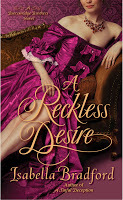
For comparison - here's another, earlier portrait of Auguste, painted when he was twenty-ish, by Thomas Gainsborough c. 1780. And for a suggestion of how he might have appeared on stage, see this video of the great Michail Baryshnikov dancing the title role in Vestris, a ballet inspired by his 18thc predecessor.
Above: Portrait of Auguste Vestris, by Adèle Romany, 1793. RISD Museum.
Below: Oh qui goose-toe! (Auguste Vestris Dancing), print made by Francesco Bartolozzi, after Nathaniel Dance; published in London by W. Humphrey, 1781.
Published on March 06, 2016 18:58
March 5, 2016
Breakfast Links: Week of February 29, 20016
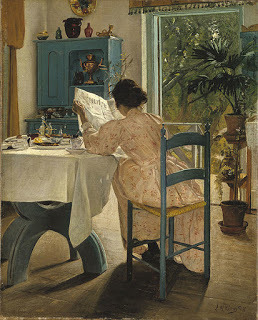 Breakfast Links are served - our weekly round-up of fav links to other web sites, articles, blogs, and images via Twitter.
Breakfast Links are served - our weekly round-up of fav links to other web sites, articles, blogs, and images via Twitter.• Fantastic collection of pictures of women at work during World War One.
• George Washington, hairdresser .
• The persistence of high heels through fashion history.
• Virginia Poe's sad acrostic valentine for husband Edgar Allen Poe.
• Love boats: the delightfully sinful history of canoes .
• Merging 18thc fashion with modern sensibilities to create the costumes for the Broadway hit Hamilton .
• Dashing World War One pilots smiled for the cockpit cameras.
• Image: Carved shell sewing kit from Paris, 1815-1820.
• George Cruikshank's 1867 illustration showed British society as a beehive .
• The art of giraffe diplomacy.
• How did Napoleon escape from Elba?
• Poignant 1,800 year old letter from a Roman soldier serving far from home.
• How cat hair brought down a pair of art forgers.
• Historical insults , thanks to the Oxford Dictionaries.
• How 43 giant, crumbling presidential heads ended up in a Virginia field.
• What did female friendships in the early 20thc. have to do with international relations?
• Image: A London bookseller's bill , 1727, for the equivalent of $25,000.
• From World War Two parachute to the world's most romantic wedding dress.
• Does sleep have a history?
• Disability in the 18thc Foundling Hospital at Ackworth.
• "And did those feet in ancient times....": cat paw prints discovered on a 17thc map of Japan.
• Ten things you probably don't know about the Queen's House in Greenwich.
• Image: A rare slashed silk doublet from 1620, one of only two that have survived.
• Playing at women's liberation, World War I, and colonialism through vintage board games.
• "Imprudent acts and great bastards": sex advice from 1861.
• Medical quackery: bloodletting .
• Mid-19thc comic manuscript illustrating verb tenses .
• A closer look at Colonel Mordaunt's Cock Fight by Johann Zoffany.
Hungry for more? Follow us on Twitter @2nerdyhistgirls for fresh updates daily.
Above: At Breakfast by Laurits Andersen Ring. Private collection.
Published on March 05, 2016 14:00
March 3, 2016
Friday Video: Exquisite Embroidery from India
Isabella reporting:
Professional embroiderers are few and far between in America today, but in India - which produces much of the world's commercial fine needlework - embroidery is still an art practiced commercially by both men and women. This short video was produced by the Victoria & Albert Museum in connection with their recent exhibition, The Fabric of India.
Here's the V&A's description for the video:
The embroiderers at the Sankalan embroidery design and production house in Jaipur, Rajasthan, practice a variety of stitch techniques to embellish fabrics by hand. The V&A followed their work on a lehnga, a wedding skirt, from traced outline to finished product. Only by slowing the footage could the incredibly fast stitching of ari embroidery be captured, as professionals perform it so rapidly it is nearly impossible to see with the naked eye.
The extremely fine hook that is being used in the video to create the chained stitches reminded me of tambour work , a kind of embroidery that was popular in the 18th-19thc. Since professionally embroidered textiles were being imported from India to France and England at the same time, I'm guessing that the technique was imported as well, and transformed with a larger hook and a French name into an elite lady's pastime. Do any of you needlework historians out there know for certain?
If you received this post via email, you may be seeing an empty space or a black box where the video should be. Click here to view the video.
Published on March 03, 2016 21:00
March 2, 2016
Fashions for March 1824
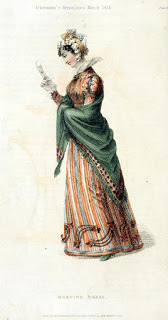 1824 Morning Dress
Loretta reports:
1824 Morning Dress
Loretta reports:Last month we looked at fashions from 1812 . This month we advance to the 1820s. By this time, the waistline has dropped, with a snug-fitting bodice, and the hems tend to be richly trimmed.
I chose these fashions from Ackermann’s Repository for March 1824, because the artist was showing figures in motion, which I think allowed the dresses to more closely approximate what they would have looked like in real life.
Unfortunately, with fashion illustrations, we tend to get a very stiff, almost cartoon-like image, while portraits as well as clothing in museum collections often show a softer flow, and fabric clinging more gently to the figure. (Some Wikipedia examples here , here , and here .)
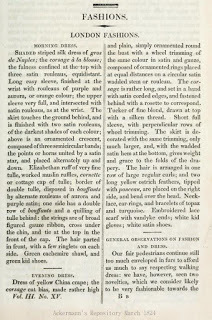 1824 Dress Description
1824 Dress Description
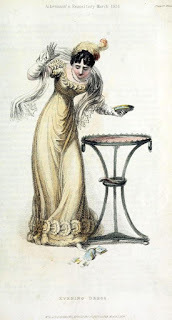 1824 Evening Dress
1824 Evening Dress
Clicking on the image will enlarge it. Clicking on the caption will take you to the source, where you can learn more and enlarge images as needed.
Published on March 02, 2016 21:30
February 29, 2016
"A Reckless Desire" On Sale Today
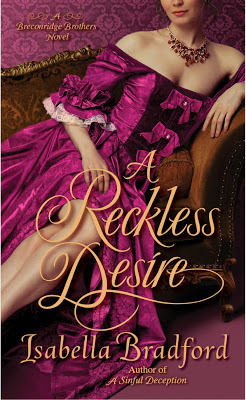 Isabella reporting,
Isabella reporting,March is roaring in like a noisy lion, and with it comes a new historical romance from me. A RECKLESS DESIRE is on sale today, everywhere and in every format - ebook, print, and audiobook.
This is the third and final book in my Breconridge Brothers trilogy (the other books are A WICKED PURSUIT and A SINFUL SEDUCTION, which are both still available), but since each one is a stand-alone book, you won't feel lost if you jump in now - although of course I hope you'll want to read all three.
A RECKLESS DESIRE is my take on Pygmalion and My Fair Lady. Set in Georgian England, it's a story of transformation: by dreams, by hard work, and by love. Lucia di Rossi dreams of becoming a great actress and escaping her dreary life as a serving-maid in her family's dance troupe. One night backstage, an expansively drunk Lord Rivers Fitzroy makes a wager with a friend that he can transform any woman – even the mousy Lucia – into the queen of the London stage. When Lucia appears on Rivers' doorstep the following morning, ready to begin her training, he has no memory of either her or the wager, although he is intrigued by Lucia.
But what begins as a drunken bet and an intellectual challenge soon grows into something more - much more. Rivers isn't prepared for Lucia's raw talent or her fierce determination, and Lucia in turn is blindsided by just how attractive her bookish tutor turns out to be. And neither of them expect the fireworks that result when his intellectual reserve meets her impulsive emotions, or that the love and passion that result will change both their lives forever.
I'll be sharing some of the inspiration behind A RECKLESS DESIRE in future blogs - including the answer to that always-asked question "Where do you get your ideas?" - which in the case of this book, actually happened right here in plain sight on this blog.
You can buy A RECKLESS DESIRE, in both paperback and ebook formats, from Amazon here , from Barnes & Noble here , from Books-A-Million here , and Powell's Books here . You can also order both paperback and ebook editions directly from Random House here .
For those of you in the UK, A RECKLESS DESIRE is published by Headline Books/Eternal Romance, who is offering it for sale here . It's also available from your local bookseller, as well as from AmazonUK here .
Published on February 29, 2016 21:00



